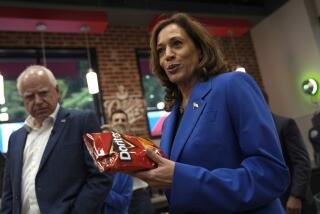Bakerâs Economic Plan Falls Short
Treasury Secretary James A. Baker IIIâs proposal that the major industrial countries monitor commodities prices--especially gold--while they try to stabilize foreign exchange rates and coordinate economic policies deserves two cheers. Itâs not a bad idea--but itâs not a good one, either.
First, prices of various commodities tend to fluctuate at different rates. During the past year, for example, raw industrialsâ prices have risen about 18%, while foodstuffs are up only about 1%. Oil is about 23% higher and gold is up 26%. Producer prices are up 2.5%, while consumer prices have risen 4.4%. Which prices would the secretary follow?
Second, these fluctuations reflect diverse developments. Supply constraints because of strikes, the weather, wars and political decisions have caused some prices to rise; others have responded to changes in demand because of the stage of the business cycle, technology, etc. Obviously, no system of currency management and economic coordination can adjust to these fluctuations--nor should it.
Looking at gold in particular raises additional questions. During the past year, the price of gold denominated in Japanese yen and West German marks has fallen, while it has risen in dollar terms. Bakerâs proposal implies that the Germans and the Japanese should loosen their economic policies while we tighten ours.
Not likely. The Germans, for one, have resisted the Reagan Administrationâs call to stimulate their economy for some time now. Their money supply is growing rapidly, causing them to worry about inflation--even though it has yet to flare up. Furthermore, they have let it be known that they will not surrender their sovereignty to any system that purports to âautomaticallyâ determine currency values.
On the other hand, Bakerâs proposal would seem to call for the United States to move to a more restrictive policy, since gold priced in dollars is up. The problem here is that fiscal and monetary policies had tightened earlier this year.
Washingtonâs budget deficit fell by one-third in the last fiscal year, while the monetary aggregatesâ growth rate has slowed enough to send short-term interest rates up by about 1.5 percentage points over the past 14 months.
At this stage in the business expansion, any further tightening raises the risk of a recession--whose probability of striking in 1988 is already far greater than zero.
The next question deals with the value of the dollar, compared to the other currencies. Because our trade deficit remains large, it is generally agreed that the dollar must fall further in foreign exchange markets--regardless of what the various price indexes show.
Indeed, until they are satisfied that our trade deficit has shrunk sufficiently, the foreign exchange markets will move the dollar lower--central bank target ranges notwithstanding. The challenge facing U.S. and other monetary authorities is how fast to let the dollar fall--and against which currencies.
Donât get me wrong. I think dampening currency fluctuations and promoting price stability are worthwhile objectives. However, these can be achieved only through harmonious economic policies among the major industrialized countries. And, as we have seen, each country still considers its own policy goals more important than cooperating with its neighbors.
More to Read
Inside the business of entertainment
The Wide Shot brings you news, analysis and insights on everything from streaming wars to production â and what it all means for the future.
You may occasionally receive promotional content from the Los Angeles Times.










